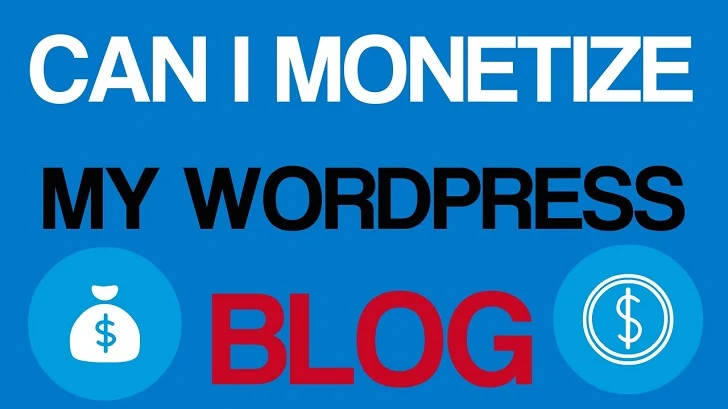To keep the site spam free, WordPress.com only allows the five following methods of monetization:
- Affiliate marketing
- Sponsored posts
- WordAds
- Selling products/services (digital & physical)
- Asking for donations/tips
I’ll explain each method in detail below, give some useful
tips, and share some of my favorite monetization tools to help you get started
quickly.
Important: We’re talking about WordPress.com (the free version)
In this article, we’re focusing on the free version of WordPress
(WordPress.com) BUT all the tips can be used on the self-hosted version too
(WordPress.org).
1) AFFILIATE MARKETING
Affiliate marketing is an advertising technique employed by brands
(including big companies like ASOS, Target, eBay, Amazon, Zappos, etc). The
brands pay bloggers commissions on sales referred through specially tracked
links.
When blogging about books you’re reading, the music you love,
clothes that strike your fancy, gadgets you’re drooling over, or whatever
interests you and your readers, feel free to post relevant affiliate links
using either text or images.
As you might expect, WordPress do NOT allow links to
gambling sites, get-rich-quick schemes, multi-level marketing programs, disreputable
merchants, pornography, malware, or phishing-type scams on their platform. They
also do not allow sites that ONLY exist to drive traffic to affiliate links.
The only catch? Some affiliate networks and platforms won’t
accept applications from WordPress.com users. This is because their service
might rely on coding or plugins that WordPress.com does not support.
WordPress recommends getting started with Amazon Associates.
They have documentation detailing how to get started with Amazon affiliate
links, which you can read here.
If you’re a fashion, beauty or lifestyle blogger, I
recommend Shopstyle Collective too. You’ll be able to link to clothing,
homewares, makeup and books from all the top retailers like ASOS, etc. They
don’t have an approval process so you can get started straight away. Here’s
some further information about using ShopStyle Collective with WordPress.com.
2) SPONSORED POSTS
How to Monetize your WordPress.com website by selling products or asking
for donations/tipsWordPress.com allow bloggers to post sponsored content on
their sites.
Here’s what’s allowed:
You can be paid to write about a product or service
You can write a post in exchange for a freebie
Somebody can provide you with an article and pay you to publish it
However, there are a couple of restrictions:
Your site should consist of MORE than just sponsored content
All content must adhere to the WordPress.com Terms of Service
FINDING SPONSORED POST OPPORTUNITIES:
Here are three different methods to help you get started:
Social Fabric by Collective Bias
Etail PR
Tap Influence
Pollinate Media
Note: I’ve not used those three agencies, so I’m not sure of their requirements
for signing up. I found the suggestions at Food Blogger Central. In that post,
you’ll find 15 other suggestions and plenty of information on ‘how to do’
sponsored posts. It’s really worth a read.
3) WORDADS
WordAdsBloggers with high levels of traffic (commonly believed to be
25,000+ pageviews per month) can run WordAds on their site. That is WordPress’s
inbuilt advertising platform (it’s similar to Google Adsense).
Unfortunately, it isn’t the perfect monetizing solution. You
only get limited control over what’s displayed on your site, you have limited
options on where to show ads and you must have a custom domain name. But if you
qualify, it’s worth trying!
4) SELLING PRODUCTS (DIGITAL AND PHYSICAL)
WordPress.com are happy for bloggers to monetize their sites by selling
either digital or physical products:
“You can sell your handmade products, art, books, or digital
products such as ebooks or courses on your site using your PayPal account.”
WordPress offer instructions for adding PayPal buttons to
your blog here.
Alternatively, you can always sell products on ETSY, Zazzle,
Gumroad and other platforms, then link to your products from your blog.
5) ASKING FOR DONATIONS OR TIPS
If you have a dedicated readership, consider asking them for donation or
tips. This is acceptable according to WordPress:
You can also solicit donations or tips from your readers
using the PayPal button or link.
How to monetize your WordPress.com blog Again, you’ll find
the instructions for adding a PayPal button to your free WordPress.com here.
If you’re providing valuable content to your readers (for
example, fiction, reviews, comics or gaming guides), you might find a Patreon
an interesting option. Your readers can purchase an on-going subscription and
pay you an amount of their choice. You can set rewards for different levels of
subscription (for example, access to a secret Facebook group, the password for
extra content, a follow on Twitter, etc). WordPress.com has just introduced
Simple Payments, which lets you create and embed credit and debit card payment
buttons on your WordPress.com and Jetpack-enabled sites with minimal setup. The
feature is available on Premium and Business plans on WordPress.com. Learn more
here.
JUST A NOTE: WORDPRESS.COM VS WORDPRESS.ORG:
My blogging platform of choice is WordPress, but I will always recommend the
self-hosted version (WordPress.org) over the free version (WordPress.com). This
is because bloggers using the self-hosted version are free to monetize their sites
however they wish. (Plus, they can install whatever plugins they like and
customize themes to their preference – handy if you want to test different
advert locations, for example).
Monetizing WordPress by selling physical or digital
productsWordPress.com is a good solution for new bloggers who want an easy way
to get started with no upfront investment. There’s no need to buy hosting, a
domain name or theme. It also makes sense for people who aren’t sure if
blogging is right for them and just want to ‘test the water’.
However, if you’re planning to take blogging seriously and generate income, you should consider using self-hosted WordPress.
